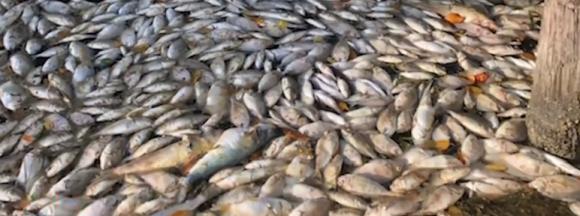 Florida is being clobbered by a double algae disaster, a virtual algae apocalypse. Red tide, caused by karenia brevis algae is decimating sea life in the Gulf’s salt waters, while blue-green algae, or cyanobacteria, is poisoning South Florida’s inland fresh water and coastal bays. The municipalities of Cape Coral and Fort Myers are being hit by both the red tide and the blue-green algal bloom at the same time.
Florida is being clobbered by a double algae disaster, a virtual algae apocalypse. Red tide, caused by karenia brevis algae is decimating sea life in the Gulf’s salt waters, while blue-green algae, or cyanobacteria, is poisoning South Florida’s inland fresh water and coastal bays. The municipalities of Cape Coral and Fort Myers are being hit by both the red tide and the blue-green algal bloom at the same time.
The Miami Herald reports that the South Florida coast has become “a red tide slaughterhouse this summer.”
Dead fish by the thousands have clogged inlets and canals. Since Sunday, 10 dead Goliath grouper, the massive reef fish that can live four decades or more, have floated to the surface. At least 90 sea turtles have been found stranded as the tide stretches well into nesting season.
In addition to killing manatees, dolphins, turtles, and fish, a whale shark is believed to have been killed by the red tide.
Red tide outbreaks are not unusual in Florida but most last from around October to February. The current red tide outbreak, the worst in decades, has lasted 10 months with no end in sight. The red tide is impacting 100 miles of coastline from Sarasota County to Collier County and is feared to be spreading northward.
Blue-green algae spreading along Florida’s east coast is threatening homes and sending people to the hospital. At least 15 people were treated last week at Martin Health System emergency rooms after having contact with the St. Lucie River. Toxic algae blooms have spread as the U.S. Army Corps of Engineers releases water from Lake Okeechobee to keep lake levels down. Governor Rick Scott this month declared a state of emergency to combat the algae blooms.
The now almost yearly blue-green algae blooms are attributed to the run-off of agricultural fertilizers from the sugar industry as well as other pollutants. In addition to killing fish and wildlife, the blooms are also unsafe for humans, affecting the gastrointestinal system, liver, nervous system and skin.
Many associate the current disaster with Governor Rick Scott, who is now running for Senate. Fabiola Santiago, writing for the Miami Herald notes:
During his eight years in office, Scott has rolled back crucial safeguards like septic-tank inspections that ensure waste isn’t seeping into water systems. He has cut almost $700 million in funding for water management districts largely responsible for the protection of waterways. He appointed water management board members more concerned with the rights of polluters than clean water.
TampaBay.com also points toward leaking septic systems and the repeal of septic tank regulations:
With toxic algae blooms now erupting all over Florida — from the St. Johns River to Lake Okeechobee as well as on both coasts — scientists are pointing a finger at one likely fuel source: pollution from leaking septic tanks.
There are more than 2.6 million septic tanks in Florida, according to the state Department of Health. But less than 1 percent of them — about 17,000 — are being inspected to ensure they don’t leak.
Scientists say that while leaks from septic tanks may not start toxic algae blooms, leaking septic tanks serve as fuel to keep the blooms going — like pouring gasoline on a fire.
In 2010, the Legislature passed a law requiring septic tank owners to get an inspection every five years to make sure they weren’t polluting. But septic tank owners rebelled, and two years later legislators repealed the inspections.
The 2012 repeal, signed into law by Gov. Rick Scott, was spearheaded by former Sen. Charlie Dean, R-Inverness. Now, looking at all the algae blooms, he’s not sure that was the right move.
“In my opinion, septic tanks are a major contributor,” Dean said in an interview this week. “If we repealed the wrong thing, then yes, it’s our fault.”
